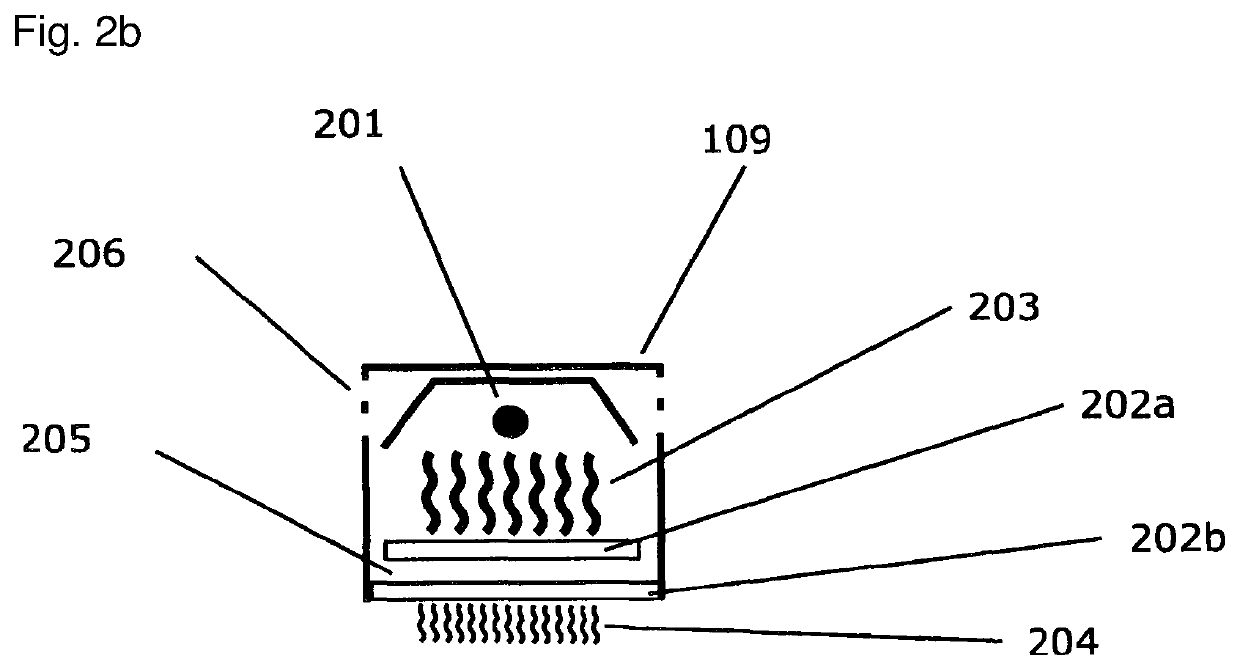Process and apparatus for producing 3D moldings comprising a spectrum converter
a spectrum converter and spectrum technology, applied in the direction of 3d object support structures, additive manufacturing with solids and fluids, pictoral communication, etc., can solve the problems of powder to “age”, powder to exceed the cost of standard polyamide by a factor of 20-30, and the particle bed cannot exceed a certain bulk density
- Summary
- Abstract
- Description
- Claims
- Application Information
AI Technical Summary
Benefits of technology
Problems solved by technology
Method used
Image
Examples
example 1
mprising a Sintering Lamp which Includes Short-Wave IR Radiators with a Radiation Filter, and a Thermal Overhead Lamp
[0148]According to FIG. 3a), the construction process or process cycle begins with the coating of one powder layer with a layer thickness of 100 μm, for example, onto the construction platform. The powder is heated by the overhead radiator (108) already during the coating process performed by the coater (101), unless optically masked by the coater (101) or the print head (100). When using PA12, in this case PA2200 from manufacturer EOS, the powder is heated to 168° C. The sintering radiator (109), which only provides radiation resulting in good heating of the printed area, is not activated in this step.
[0149]The overhead radiator (108) includes a measuring device designed to control the surface temperature of the construction field. Ideally, the measuring device is embodied as a miniature pyrometer (112) which can determine the temperature in a contactless manner. The...
example 2
a Sintering Lamp, Provided with a Cooling Function
[0155]FIG. 2b and FIG. 2c show an embodiment of the sintering lamp with integrated cooling. The radiation filters are schematically shown in duplicate (202a, 202b) by way of example. Both elements are not in contact, but are arranged with a certain distance (205) between them. In this design, most of the long-wave infrared radiation generated is absorbed by the filter (202a) which is closest to the short-wave radiator (201). The latter is heated by the long-wave infrared radiation, but allows the short-wave radiation to pass through. Thus, the second filter (202b), which faces the particle surface according to FIG. 1, is not heated by this long-wave thermal radiation. The second filter also leaves the short-wave radiation unaffected, so that it can be used to heat the area of the particle material wetted by the print head (100) to a temperature above its melting temperature. The now much lower temperatures of the second filter preven...
example 3
a Sintering Lamp, Provided with a Cooling Function and a Diffuser
[0157]As indicated in FIG. 2d, a design of the filter (202b) described in Example 2 as a diffuser (202c) makes sense in order to uniformly irradiate the entire surface of the particulate material on the construction platform when the sintering lamp passes over it (204b). This ensures that a sufficiently high strength of the molded article to be produced can also be achieved in the edge regions of the construction platform. In this example, cryolite glass, white opal glass from manufacturer Edmund Optics, is suitable as a diffuser.
PUM
| Property | Measurement | Unit |
|---|---|---|
| wavelength | aaaaa | aaaaa |
| volumes | aaaaa | aaaaa |
| temperature | aaaaa | aaaaa |
Abstract
Description
Claims
Application Information
 Login to View More
Login to View More - R&D
- Intellectual Property
- Life Sciences
- Materials
- Tech Scout
- Unparalleled Data Quality
- Higher Quality Content
- 60% Fewer Hallucinations
Browse by: Latest US Patents, China's latest patents, Technical Efficacy Thesaurus, Application Domain, Technology Topic, Popular Technical Reports.
© 2025 PatSnap. All rights reserved.Legal|Privacy policy|Modern Slavery Act Transparency Statement|Sitemap|About US| Contact US: help@patsnap.com



